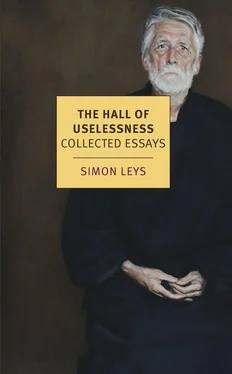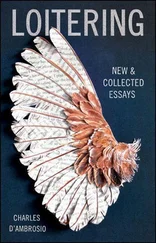Schlumberger once pointed out to Gide a mistake he had made in a translation from Goethe, but he was shocked by Gide’s reply: “I know, I have tried to put it differently, but all my other versions lacked in rhythm.” Schlumberger commented: “I have noted this reaction, as, once again, it shows his constant willingness to sacrifice meaning to form.” ( Schlum ., p. 236.)
The Tiny Lady summed up: “I believe that he attaches so much importance to the question of form, that the question of content ceases somehow to interest him.” ( PD 4, p. 16.) Earlier on, after reading his Journal , she put the question to him: “I confess I do not always understand why you select certain things for recording in your diary, whereas you omit other things that should have been equally, or more, interesting. Could it be that your choice is simply determined by the possibility of finding at once a form that is pleasing?” Gide confirmed the accuracy of her guess. ( PD 3, p. 361.)
160. PD 4, p. 233.
161. Paul Claudel: Journal 1, p. 969.
162. Schlum ., pp. 176, 246–7.
163. PD 2, p. 376.
164. PD 3, p. 78; Sheridan, p. 525.
165. Et nunc manet in te and Journal 1, p. 1, 310; also Sheridan, p. 524.
166. This was addressed to Madeleine, and she had read it before marrying André. See Martin , p. 84.
167. Account of Martin du Gard (1920), quoted by J. Schlumberger: Madeleine et André Gide , p. 186.
168. Et nunc manet in te , pp. 1, 128–9; and Sheridan, p. 525.
169. Et nunc manet in te (in the 1960 Pléiade edition of Journal 1939–1949 ), p. 1, 134.
170. Schlum ., pp. 178–9, 220.
171. Account of Martin du Gard, quoted in Schlumberger: Madeleine et André Gide , p. 191–2.
172. Account of the Tiny Lady, quoted in Schlumberger, op. cit ., pp. 196–7.
173. Et nunc manet in te, op. cit. , p. 1, 148.
174. Martin , pp. 61–2.
175. Martin , pp. 131–2.
176. PD 2, p. 70.
177. Journal 1, pp. 798–801.
178. Journal 2, pp. 487–8.
179. Journal 1, p. 720.
180. PD 2, p. 531.
181. Well described by Sheridan, pp. 445–90. Quotes not otherwise identified here are drawn from Sheridan’s account.
182. PD 2, p. 204.
183. Schlum ., p. 167.
184. Martin du Gard, Journal 2 (27 November 1936), pp. 1, 208–9.
185. PD 3, p. 198.
186. PD 3, p. 201.
187. PD 3, p. 205.
188. Martin du Gard, Journal 3, p. 404.
189. Schlum ., p. 266.
190. PD 4, p. 190.
191. Schlum ., p. 16. (Quoted from La Porte est ouverte in Paul Mercier’s preface.)
192. Si le grain ne meurt , quoted in PD 2, p. 128; Journal 1, p. 573.
193. Martin du Gard, Journal 2, pp. 232–3.
194. Martin , pp. 96–8.
195. PD 2, p. 114.
196. Schlum ., p. 368. On that same page, Schlumberger had just noted that Mauriac told him after reading the memoir of Jean Lambert (Gide’s son-in-law), which alluded to the old man’s monomania: “We must face the fact: Gide was truly a sick person, one of those madmen who need to be locked away.” (Once again, it should be recalled that Mauriac was himself a repressed homosexual, and that he had a genuine friendship with Gide.)
197. Gide’s moral blindness and capacity for self-deception staggered even his closest friends. Martin du Gard tells how Gide’s daughter, who was seventeen at the time, had become the object of the timid sentimental attentions of one of her former teachers. Gide was indignant and wanted to write to the man: “Sir, stop bothering this child. I forbid you to meet her again.” The situation, he said, was “odious.” This reaction bemused Martin: “Our good old Gide has in fact spent all his life committing breaches of trust that were far more severe! How many times did he worm his way into a friendly family, multiplying warm approaches to the parents, with the sole purpose of getting closer to their son — sometimes a thirteen-year-old schoolboy — and of joining him in his room, arousing his sexual curiosity, teaching him sensual pleasure! He was more clever than Catherine’s teacher, more diabolic with his temptations, more daring also. How many times did he succeed in hoodwinking the parents, in securing the complicity of the child, in indulging with him in sweet and perverse games? But then, to his mind, there was nothing ‘odious’ in this premeditated debauching of a young boy, whom his parents had entrusted to his friendly care!” (Martin du Gard, Journal 3, pp. 361–2.)
198. PD 4, pp. 253–4.
199. PD 2, p. 406.
200. Béatrix Beck tells in her memoirs: “Some time after the death of Gide, Dominique Drouin (his nephew) told me that the Tiny Lady had confided to him: ‘I have to fetch a little Annamite for him, and when I cannot find any, I act as a substitute.’ And Drouin added: ‘When you think of these two bags of bones.’… I have a strong visual imagination and I somatise easily: I had to vomit on the spot.” ( Beck , p. 161.)
201. Schlum ., p. 346.
202. PD 4, p. 252.
203. Béatrix Beck, Preface to M. Saint-Clair, Il y a quarante ans , p. iv.
204. Sheridan, pp. 370 and 633.
205. Schlum ., p. 96.
206. Schlum ., p. 150.
207. PD 2, p. 58.
208. Quoted in PD 3, p. 16.
209. PD 4, p. 204.
210. Saint Augustine: Confessions , X, (xxiii) 34: “Sic amatur veritas, ut quicumque aliud amant, hoc quod amant velint esse veritatem, et quia falli nolent, nolunt convinci quod falli sint. Itaque propter eam rem oderunt veritatem, quam pro veritate amant.”
MALRAUX
1. In November 1996, on the twentieth anniversary of his death, Malraux was awarded the form of immortality which the French nation bestows upon its most illustrious cultural heroes: his mortal remains were moved with great pomp into the Pantheon in Paris.
2. La Tragédie de la révolution chinoise , translation by R. Viénet (Paris: Gallimard, 1967).
3. J. Andrieu, “Mais que se sont dit Mao et Malraux?” in Perspectives Chinoises , No. 37, October 1996. (An abridged version of this article was published in Le Nouveau quotidien , Lausanne, 3 December 1996.)
4. G. Duthuit, Le Musée inimaginable (Paris: José Corti, 1956). Duthuit pointed out, with great scholarly accuracy, the countless historical howlers in Malraux’s Musée imaginaire: les voix du silence . He also exposed his hollowness, obscurity, logical non sequiturs, and other factual mistakes. His demonstration (in two volumes of text and one volume of illustrations) was brilliant, rigorous and devastating — but it reached only a small circle of specialised scholars.
5. B.Chatwin, What Am I Doing Here? (London: Picador, 1990), p. 133.
6. The Nabokov — Wilson Letters 1940–1971 , ed. Simon Karlinsky (London: Weidenfeld & Nicholson, 1979), p. 175.
7. J.-P. Sartre, Lettres au Castor (Paris: Gallimard, 1983), Vol. 2, pp. 159, 167, 163, 192.
8. Letter to Roger Nimier, 8 January 1953 (in Jacques Chardonne — Roger Nimier, Correspondance , Paris: Gallimard, 1984, p. 91.) Two samples of Malraux’s galimatias (out of possible hundreds) are provided by Curtis Cate (p. 372): “The language of Phidias’ forms or of those of the pediment of Olympia, humanistic though it is, is also as specific as that of the masters of Chartres and Babylon or of abstract sculptures, because like that of the great Italians of the fourteenth to the sixteenth centuries, it simultaneously modifies the representation and its style.” Or again: “Between Cézanne’s Still Life with Clock , which strives only to be a painting, and his canvases which have become a style, there resurfaces the call which raises up Bach over and against negro music, and Piero della Francesca over and against barbarian arts — the art of mastery, as opposed to that of the miracle.”
Читать дальше












